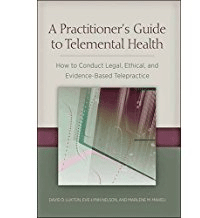“A Practitioner’s Guide to Telemental Health: How to Conduct Legal, Ethical, and Evidence-Based Telepractice”

“A Practitioner’s Guide to Telemental Health: How to Conduct Legal, Ethical, and Evidence-Based Telepractice”
By David D. Luxton, Eve-Lynn Nelson, and Marlene M. Maheu
American Psychological Association
Washington, D.C., 2016
Telehealth `how to’ resource is impressive
Reviewed by James K. Luiselli, Ed.D., ABPP, BCBA-D
Telecommunication technologies have greatly enhanced the delivery of mental health services. Broadly defined, telemental health (TMH) is conducting assessment, treatment, supervision and consultation through videoconferencing, desktop Web cams, interactive Web sites, mobile device applications and similar platforms.
The chief attraction of electronic media is that practitioners can offer services to patients and other consumers who cannot travel to a traditional office or clinic setting. Furthermore, TMH is affordable, can reach underserved populations and may be more accommodating for individuals who are reluctant to seek conventional service options.
The benefits of TMH notwithstanding, there are many practical, ethical, regulatory and legal concerns that govern acceptable implementation. This guidebook comprehensively reviews these areas and more “for the new telepractitioner who wants to get started, the seasoned practitioner who seeks to continue to enhance TMH practice, the supervisor who engages in telesupervision and the clinical manager or administrator interested in training a clinical team.”
The guidebook is intended for TMH providers regardless of discipline and theoretical orientation. Most of its content focuses on the process of delivering real-time psychological services via videoconferencing equipment, although email, text messaging, and related technologies are also covered.
In 10 concise and clearly written chapters, the authors detail just about everything to know for starting, maintaining and administering telepractice. The chapters can be considered separately but they are complimentary and integrative at the same time. The guidebook is packaged attractively in paperback format, reasonably priced and easy to handle at the office or in transit.
The authors orient the reader through a solid presentation of TMH pragmatics, which I found extremely informative. Some of the key steps are mastering technology basics, troubleshooting equipment glitches, ensuring confidentiality, securing privacy data and staying compliant with federal and state telehealth requirements.
With regard to psychological services, the authors concentrate on assessment, establishing therapeutic rapport, performing supervision and consulting. Most appropriately, they adopt a patient-centered approach that is sensitive to clinical diversity, a lifespan perspective and “how cultural factors and the broader community may influence the telepractice encounter and sustainable TMH service.”
The subtitle of this guidebook truly speaks to the essential qualities of exemplary TMH. Each chapter demonstrates convincingly how telepractice should be implemented according to competency standards and ethical guidelines that are in the best interest of patients and practitioners.
In 2017, it is essential that mental health professionals learn about technology advances for serving the broadest population of patients and consumers. Reading this book will fulfill that mandate emphatically – it is a rich “how to” resource that should not be missed.
James K. Luiselli, Ed.D., ABPP, BCBA-D, is Chief Clinical Officer, Clinical Solutions, Inc. and North East Educational and Developmental Support Center, Tewksbury, Mass..
Learn more about the book: A Practitioner's Guide to Telemental Health: How to Conduct Legal, Ethical, and Evidence-Based Telepractice
